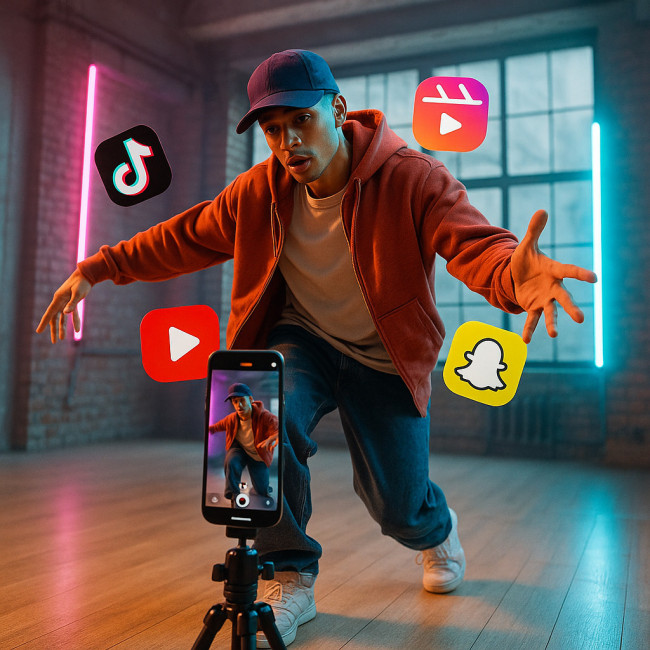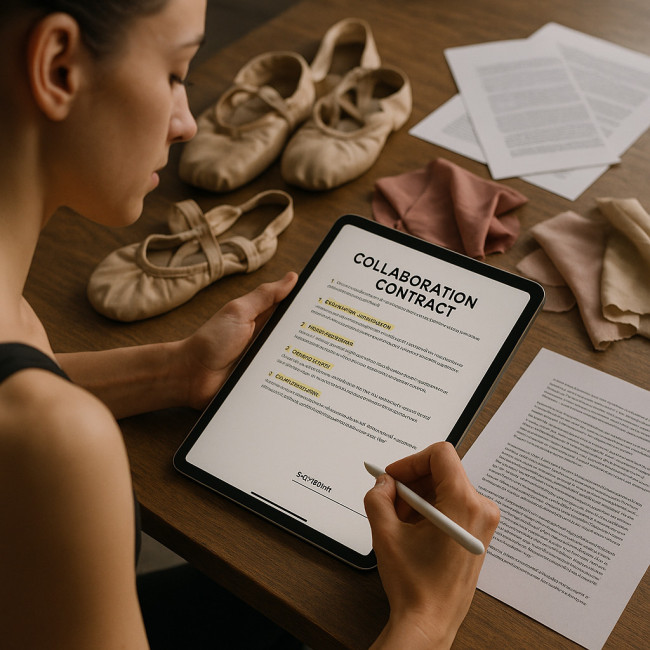Paid dance collaborations on social platforms: rates, clauses and creative control
Wondering how much you should charge for a sponsored choreography on TikTok or a Reels duet on Instagram? This guide walks you through current market rates, must-have contract clauses, and strategies to keep creative control when negotiating paid dance collaborations on social platforms.
Why paid dance collaborations are booming
The creator economy now tops $250 billion, and dance content ranks among the most watched micro-formats. Brands realise that a well-timed shuffle challenge can move product faster than a glossy TV spot. Meanwhile platforms reward short, high-energy clips—precisely what dancers do best. To put the trend into perspective, recent reports show that clips featuring a recognisable hook step hold viewer attention for up to 13 seconds—nearly double the average watch time for lifestyle vlogs—thus triggering the algorithmic loops that drive viral lift and, ultimately, brand spend.
- Attention magnet: Dance videos generate up to 2× higher completion rates than static ads.
- Low production cost: One phone, one tripod, one dancer—that's enough for a viral asset.
- Cross-platform portability: A 15-second routine can run on TikTok, Instagram, YouTube Shorts and Snapchat Spotlight with minimal edits.
All this translates into increasing budgets for dance-first influencer deals.
Typical rate cards by platform

This expanded overview helps creators contextualise the raw numbers in the table. Remember that a so-called “micro” dancer with sky-high watch-through time can legitimately quote more than a disengaged macro account, and regional purchasing power also skews expectations: a 50-second K-pop freestyle shot in Seoul might outprice a Broadway-style tap recorded in Kansas. When benchmarking, weigh CPMs in your niche, brand fit, seasonality, and whether the brief includes usage for paid social amplification or merely organic posting. Add a buffer for unexpected rounds of feedback, wardrobe changes and track licensing—these extras often add 15 % or more to the sticker price.
Rates vary by follower tier, engagement, region and usage rights. The table below summarises 2024 benchmarks for a single sponsored post featuring a dancer as the main creator.
| Platform | Micro (10 K–100 K) | Mid-tier (100 K–1 M) | Macro (>1 M) | Usage period |
|---|---|---|---|---|
| TikTok | $300 – $1 200 | $1 200 – $7 500 | $8 000 – $35 000 | 12 months |
| Instagram Reels | $250 – $1 000 | $1 000 – $6 000 | $7 000 – $30 000 | 12 months |
| YouTube Shorts | $350 – $1 400 | $1 400 – $8 000 | $9 000 – $40 000 | 24 months |
| Snapchat Spotlight | $200 – $800 | $800 – $4 500 | $5 000 – $25 000 | 6 months |
Need a deep dive on pricing transparency? Check out our guide on setting fair dance fees online.
Source : Influencer Marketing Hub
Key contract clauses every dancer should nail

Treat the negotiation phase like a dress rehearsal: the clearer each marking point, the smoother the final performance. A robust contract gives both sides a shared choreography of expectations, preventing last-minute improvisation that costs money and momentum. Specify shoot dates, backup dates, file-delivery specs and who pays for props or additional dancers. Clarify whether bilingual captions are required, how quickly performance analytics must be supplied, and which jurisdictions govern potential disputes. Investing an extra hour upfront to word these points precisely shields your artistic brand from scope-creep fatigue and ensures you can keep dancing, not chasing emails.
A one-page DM agreement is not enough. Lock down these points before you hit record:
- Scope of work. Spell out deliverables: number of videos, length, resolution, captions and hashtags.
- Usage rights. Will the brand boost the clip as an ad? If yes, charge an extra 20–50 % depending on duration.
- Exclusivity window. Avoid conflicts by specifying categories and time frames. A soda brand can request beverage exclusivity for 30 days—nothing longer without premium pay.
- Approval rounds. Limit feedback to two revisions to prevent endless reshoots.
- Payment terms. Secure 50 % on signing, 50 % within seven days of post go-live.
- Cancellation fee. Incurred costs? Recover at least 30 % of the total fee if the brand pulls the plug last minute.
For theatre-style bookings, consult our primer on one-night dance gig contracts.
Keeping creative control while staying brand-safe
Drafting a collaborative concept deck
Start with a mini mood-board, then ask the brand to approve music, costume palette and key moves. This safeguards artistic integrity and accelerates sign-off.
Using platform features to your advantage
- Stitches & duets: Frame your clip so you can later reuse it without the brand's tag line.
- Original audio uploads: Register the track to maintain attribution when others remix your routine.
- Pin comments: If you must add a legal disclosure, pin it rather than cluttering captions.
Negotiating final cut rights
Brands may request raw files “for safety”. Grant them review access, not edit rights. If a re-edit is non-negotiable, include a clause that any changes require written permission.
Workflow: from pitch to posted video
- Research. Identify products aligning with your style. Browse current collaboration briefs to spot gaps.
- Pitch. Send a concise media kit, a concept seed and a fee range.
- Contract. Finalise scope, usage, payment and timeline.
- Pre-production. Block choreography, test camera framing, draft captions.
- Shoot & edit. Aim for 80 % daylight takes to minimise colour correction.
- Approval. Share an unlisted link; collect feedback in one document.
- Publish & amplify. Go live at peak engagement, then cross-post within one hour.
- Report. Deliver analytics after 48 hours and again at 30 days.
Need to speed up scouting and approvals? Learn the art of rapid profile scanning.
Legal and tax considerations
In many countries, a sponsored clip counts as advertising. Declare income accordingly and respect local ad disclosure rules (#ad, Paid partnership tag, etc.). U.S. creators must issue a W-9 to brands, while EU-based dancers may need to charge VAT.
FAQ
- How often should I raise my rates?
- Review every six months or once your engagement rises by 25 %. Document growth in a rate card.
- Can I repost brand content on my own channels?
- Yes, if the contract grants mutual usage rights. Otherwise request written consent.
- What if a brand requests new music after signing?
- Offer options within the same licence price band. Additional clearances justify a fee increase.
- Are duet responses paid separately?
- Typically yes. Quote 60–70 % of your main post fee for each follow-up.
- How long should I keep the sponsored post live?
- Standard is 12 months. Anything longer should carry a renewal fee.
Check your collaboration IQ
Next steps
Paid dance collaborations on social platforms remain one of the fastest ways to monetise your moves. Draft a solid contract, price confidently, and keep your creative fingerprint front-and-centre. Ready to pitch? Download our free rate card template and start outreaching today.











